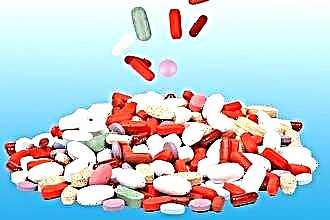An antibiotic is a very powerful drug that can kill pathogenic microorganisms. Before its discovery, some respiratory diseases threatened with dangerous complications, up to and including death. And now antibiotics can quickly cure serious diseases. But the uncontrolled intake of such drugs can harm the body no less than their absence. Especially if they are used to treat children.
Indications for use
Throat antibiotic for children should be selected solely for medical reasons. Therefore, they usually do not give it to the baby until they have  the results of laboratory tests were obtained: bacterial inoculation of mucus from the throat and a general blood test. They allow you to determine the intensity of the inflammatory process, and what microorganisms it is caused by.
the results of laboratory tests were obtained: bacterial inoculation of mucus from the throat and a general blood test. They allow you to determine the intensity of the inflammatory process, and what microorganisms it is caused by.
To decide at the initial examination how justified the intake of antibiotics is in this particular case, the following symptoms indirectly help:
- severe sore throat;
- difficulty swallowing;
- a sharp increase in body temperature;
- noticeable swelling of the tonsils;
- severe redness and swelling of the throat mucosa;
- white or purulent plaque on the tonsils and mucous membranes;
- headache and a feeling of bloating in the sinuses;
- severe pain when chewing or swallowing;
- Sharp ear pain (possibly with discharge)
- swollen lymph nodes;
- shortness of breath, severe wheezing.
Most likely, in this case, there is a strong purulent-inflammatory process. It can be a type of sinusitis, tonsillitis, bronchitis, or pneumonia. All of these diseases can be accompanied by cough, pain when swallowing, and redness of the throat.
But in order to make the final diagnosis, anticipate the development of complications and choose the right drug, it is necessary to undergo an additional examination.
Before a full diagnosis, a broad-spectrum antibiotic can be prescribed to a child if, for some unknown reason, the temperature has risen to 39 degrees in children from 3 years of age and above, and 38 in infants. After receiving the results, the dosage of the drug can be adjusted or replaced with another.
Application features
Even if a doctor has prescribed an antibacterial drug for a child, it must be taken with caution. This is a potent remedy that requires careful attention to yourself. There are some rules that are very important to follow throughout the course of treatment:
 It is necessary to take, cancel or replace antibiotics only as directed by a doctor.
It is necessary to take, cancel or replace antibiotics only as directed by a doctor.- Carefully observe the dosage and time of taking the drugs, do not compensate for the missed dose by increasing the next dose.
- Drink antibiotics only with clean water, if there are no other recommendations in the instructions.
- The first intake of the drug should be started with a minimum dosage in order to avoid a severe allergic reaction.
- If side effects appear (except for severe allergies), immediately inform your doctor about them, but do not stop taking the drug yourself.
- Completely complete the entire course of antibiotic treatment, otherwise the surviving microorganisms will develop resistance to the drug, and the next time it will not work.
- Give the child a lot of water, as it accelerates the absorption of the drug in the intestines and the elimination of its decay products.
- Pay attention to the combination of an antibiotic with other drugs or used folk remedies: they can enhance or weaken its effect.
- Follow a sparing diet, include lactic acid products in it - this will facilitate the work of the gastrointestinal tract and liver, on which the medicine creates an additional load.
- After completing the course of treatment, be sure to give the baby probiotics to help restore the disturbed intestinal microflora.
In some cases, especially with a severe form of the disease, when a quick therapeutic effect is needed, antibiotics are best used in the form of injections. Often, injections are prescribed to infants, since the harm from them is less than from getting the medicine into the gastrointestinal tract.
Although all children are afraid of injections, if a doctor recommends just this form of therapy, you should not unreasonably refuse it.
Choice of antibiotics
What antibiotics to use for throat ailments in children in each case, the doctor decides. There are no “children's” medicines, and this is the main danger. Any antibiotic for a child is a potent and potentially dangerous drug. Even a minimal overdose or the wrong choice of medication can lead to multiple side effects and even impaired development of the child's body.
 Depending on the condition and diagnosis, children can be prescribed different types of antibiotics: penicillins, macrolides, cephalosporins and lincosamides. Each of the types has its own characteristics of use, indications and contraindications, which the doctor must take into account when prescribing.
Depending on the condition and diagnosis, children can be prescribed different types of antibiotics: penicillins, macrolides, cephalosporins and lincosamides. Each of the types has its own characteristics of use, indications and contraindications, which the doctor must take into account when prescribing.
Some of the medications most commonly used by pediatricians for sore throat conditions are:
- "Amoxicillin". A broad-spectrum drug on a semi-synthetic basis, which is harmful to most bacteria. It is rapidly absorbed into the blood, does not irritate the gastric mucosa.
- "Bitsillin". It is ineffective in case of damage by gram-negative microorganisms, it copes well with all the rest, while having anti-inflammatory properties.
- "Ampicillin". The most inexpensive drug of the penicillin series, but allergic reactions often occur to it, so use it for the first time with great care. A broad spectrum drug with minimal side effects.
- "Amoxiclav". Complex preparation of a wide spectrum, which has proven itself especially well in the treatment of angina. Of the side effects, most often there is a lack of appetite, minor skin rashes, and changes in blood pressure.
- Erythromycin. It is especially aggressive to staphylococci, while not too toxic to the body. If necessary, it can be prescribed even during pregnancy, does not lead to fetal malformations.
- Lincomycin. It is prescribed for any infectious diseases of the upper respiratory tract. Gives good results in the treatment of tonsillitis, pharyngitis, purulent sinusitis.
- Clindamycin. An effective drug for the treatment of staphylococcal infections. Low toxicity, quickly excreted from the body. Able to very quickly destroy pathogenic bacteria.
The listed drugs are systemic antibiotics and are used in the form of tablets or injections. It must be remembered that they do not have antipyretic or analgesic effects, therefore, most likely, you will have to combine antibiotics with other drugs.
Topical preparations
A more gentle form is topical antibacterial drugs that are used to gargle or irrigate the throat. Of course, they also enter the bloodstream, but in much smaller quantities. But when treating the throat with such drugs, the antibiotic goes directly to the affected area, so its effectiveness is quite high:
 "Bioparox" is a complex preparation, produced in the form of a spray, and also has an anti-inflammatory effect.
"Bioparox" is a complex preparation, produced in the form of a spray, and also has an anti-inflammatory effect.- Chlorhexidine is an antiseptic solution used to gargle and irrigate the throat.
- "Grammicidin" - is used to treat tonsils with angina or larynx with bacterial pharyngitis.
- "Stopangin" is used for children in the form of a spray (from 12 years old - lollipops), the main active ingredient is benzocaine.
- "Faringosept" - absorbable lozenges, with antibacterial and antiseptic effect, indications: tonsillitis, pharyngitis, laryngitis.
Local preparations are best used several times a day, after rinsing the throat with a saline or soda solution (depending on the diagnosis). It is necessary to take into account their interaction with systemic antibiotics so that an overdose does not happen. Therefore, it is impossible to use them in addition to the already prescribed medication without the knowledge of the pediatrician.
Side effects and contraindications
The first and most serious contraindication to any type of antibiotics is individual intolerance to the drug or the entire group to which it belongs. It can manifest itself in a sharp manifestation of many side effects or a strong allergic reaction. Therefore, any new antibiotic should be given to the child after the test (subcutaneous injection) or in the minimum dosage, while it is advisable to have a good antihistamine on hand.
Contraindications to most antibiotics are serious disorders in the work of internal organs: liver, kidneys, stomach and intestinal ulcers. The drug can cause intestinal disorders in a child with chronic dysbiosis, since it has a detrimental effect on the intestinal microflora.
The most common side effects from taking antibiotics are:
 nausea, vomiting, diarrhea;
nausea, vomiting, diarrhea;- skin rashes;
- loss of appetite;
- conjunctivitis;
- dermatitis;
- decreased immunity;
- aplastic anemia.
Most often, side effects occur with the wrong selection or overdose of the drug, as well as due to its use with other drugs that are not compatible with it. This usually happens when self-prescribing antibiotics.
Throughout the course of treatment, it is important to monitor the general condition of the child and the characteristics of the course of the disease. After the appointment of antibiotics, noticeable improvements occur as early as 2-3 days. If this does not happen, it is possible that the drug is not working and it is necessary to replace it with another one. It is imperative to inform the attending physician about this, and not to continue the course of treatment thoughtlessly or cancel it yourself.
Alternative remedies
With a severe form of throat disease and the presence of complications, there is currently no worthy alternative to antibiotics.
But if the disease is at an early stage, strong immunity in combination with proven traditional medicine can well cope with pathogens.
 If the body temperature does not exceed 38 degrees, and there is no purulent discharge, then it makes sense to try to treat the baby at home. Decoctions of eucalyptus, St. John's wort, elecampane have pronounced antibacterial properties.
If the body temperature does not exceed 38 degrees, and there is no purulent discharge, then it makes sense to try to treat the baby at home. Decoctions of eucalyptus, St. John's wort, elecampane have pronounced antibacterial properties.
A decoction of chamomile, calendula, sage has an anti-inflammatory effect. Herbs are used to rinse and gargle.
An excellent healing effect is provided by steam inhalation with decoctions of the above herbs, soda solution or essential oils dissolved in water: eucalyptus, fir, tea tree, cedar, thuja. Babies up to 6 months old cannot do inhalations with sore throat - they can increase the swelling of the mucous membrane, and the child will begin to choke.

 It is necessary to take, cancel or replace antibiotics only as directed by a doctor.
It is necessary to take, cancel or replace antibiotics only as directed by a doctor. "Bioparox" is a complex preparation, produced in the form of a spray, and also has an anti-inflammatory effect.
"Bioparox" is a complex preparation, produced in the form of a spray, and also has an anti-inflammatory effect. nausea, vomiting, diarrhea;
nausea, vomiting, diarrhea;

